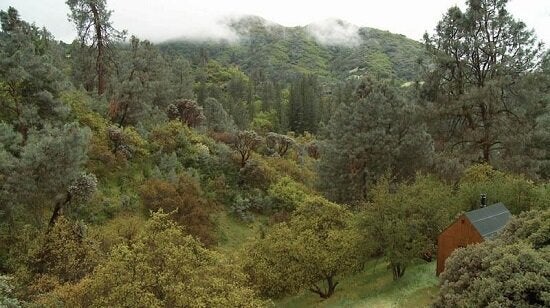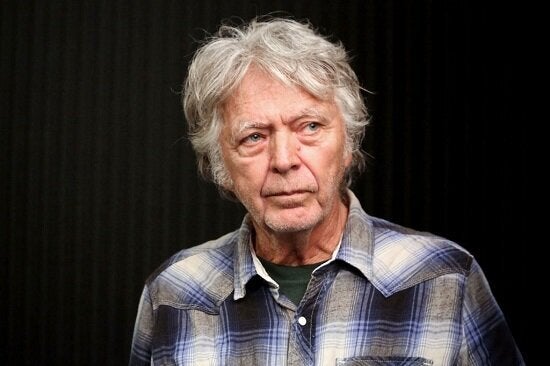
American documentary filmmaker James Benning's new film about the Unabomber, Stemple Pass, is one of the few true must-sees in this year's VIFF, and plays tonight for the final time. There is more than a usual amount of urgency in recommending audiences get out to see the film while they can, since it is unlikely that it will screen theatrically elsewhere: although Benning regularly has films in VIFF, none, to my knowledge, have yet returned for an engagement in Vancouver. The film may also never see distribution on home video, which is possibly a good thing; the challenges and rewards of Benning's cinema are such that you pretty much have to see his films on the big screen, with an audience, where there is no option of pausing the film, no way to dodge the demands placed on you.
To be precise about those demands: this time out, the entire, two hour film is comprised of four static shots of the same landscape, each approximately 30 minutes long, and a few titles in between. Each of its four segments contains approximately fifteen minutes of Benning reading from the Unabomber's journals and other writings, and fifteen minutes where all you hear is the ambient sound of the landscape -- the forest around Benning's reconstruction of the Unabomber's cabin. Sitting and listening to the sound of birds, weather, and a nearby stream may seem daunting, but in fact is no more so than trying to meditate in nature for fifteen minutes at a stretch; the film, in fact, goes by far faster than you might expect, and contains some fairly startling revelations about Ted Kaczynski -- as when he writes that his early acts of sabotage are motivated not by ideology or a desire to change the world, but by a desire for "revenge" on the technological society that he feels has deprived him of autonomy. (Be advised that some of Kaczynski's writing is somewhat upsetting to contemplate; Benning makes no attempts to whitewash the violence of Kaczynski's crimes).
For more reading on the Unabomber and the film, the Unabomber's anti-technological manifesto can be read online here; you can read more about James Benning's cabin project here - which also saw him reconstructing Henry David Thoreau's cabin at Walden Pond; and readers may be interested in my somewhat longer review of the film, here. People interested in the topic of the Unabomber are also directed to check out Lutz Dammbeck's film The Net: The Unabomber, LSD, and the Internet - viewable on Youtube .
It may interest those familiar with that film that Benning has not, as of this writing, seen it. Readers may also find interest in this article about Unabomber victim David Gelernter's opposition to the auctions that made Stemple Pass possible.
Thanks to James Benning for taking time to answer a few of my questions by email. (We only had time for a few quick questions, but I trust Benning's answers will be of interest to those who have seen the film).

James Benning interview
Allan: How did you get access to the Unabomber's journals? What sort of principles of selection did you use, deciding what passages to read?
James: I read all 40 of his journals purchased by a friend a few years ago when they were auctioned off by the FBI. The entries I used give an overview of the kinds of things he was writing about.
Allan: Did the cabin you built have a fully functioning fireplace?
James: The Thoreau cabin has a functioning fireplace, the Kaczynski cabin has a small functioning wood stove.
Allan: Has anyone lived there for any length of time?
James: The two cabins now each has a replica bed and a table. I sleep in them from time to time. My daughter Sadie wrote a lot of music in the Thoreau cabin during the daytime, but never lived in either cabin.
Allan: Who was inside the cabin, feeding the fire, while the filming was taking place?
James: I was inside the cabin keeping the fire burning while the camera was unattended filming from the porch of my main house.
Allan: Why was there no smoke during the winter segment?
James: He was out hunting.
Allan: I know that you do not always use audio that was recorded at the same time as your images (I remember someone getting incensed with you for "cheating" at a past VIFF for using train sounds to accompany a sequence of 13 Lakes, which were actually recorded at a different time at the same location). So I must ask about the audio -- and especially the helicopter! Did you "cheat," so to speak, and add the helicopter in by some means, to resonate against Kaczynski's writings about noise?
James: Helicopters pass by my house, but infrequently, and when they do, it means one of two things, there is either a mariijuana bust about to happen, or there is a forest fire nearby. The sound immediately catches my attention. All the sounds in Stemple Pass were recorded on location, but a few of them aren't sync. The helicopter sound is one of them. I recorded it a week before I made the shot that it is in.
Allan: Are there any other sounds that you added or non-sync sound elements you chose to employ?
James: No not really, but I removed a few car sounds that were louder than usual.
Allan: Was the audio actually recorded in proximity to the cabin?
James: 99 per cent of the sound is recorded in sync, both with a mic feeding into the camera, and with a Sound Devices digital recorder that was positioned next to the camera. Any sounds that were added were also recorded from this same location, that is, off my porch that overlooks the cabin and the distant mountain.
Allan: Out of curiosity: do you/ have you hunted?
James: I grew up in a family that hunted, but I never did.
Allan: Some of Kaczynski's stories might be upsetting to animal lovers (foetal squirrels for the stew..). Why did such passages call out for inclusion?
James: Well the majority of people on this earth eat meat, and the majority of meat eaters don't kill their own food. Most people don't want to think about the bolt being driven into a cow's skull while they're chewing that medium-rare steak, or the bullet tearing through the brains of a snowshoe rabbit. We've lost the autonomy that most people possessed in the not too long ago past. Today all the dirty work is outsourced.
Benning also briefly informed me of the books that he included in his reconstruction of Kaczynski's cabin, used in the film.
"Half are from my library, the other half are some of the 238 books found in Kaczynski's cabin when he was arrested," Benning explains. These include Kaczynski's "favourite book as a child" -- Ernest Seton-Thompson's Wild Animals I Have Known; books apropos of Kaczynski's means of survival as a hunter-gather (including an NRA manual on rifle shooting; Murie's A Field Guide to Animal Tracks; and the Euell Gibbons Handbook on Edible Wild Plants); various works of literature (Of Mice and Men, The Merchant of Venice, 1984, Life on the Mississippi, The Razor's Edge, A Tale of Two Cities, Darkness at Noon, The Secret Agent) and works of political philosophy (including Eric Hoffer's The True Believer, Jacques Ellul's Autopsy of a Revolution and The Technological Society; Machiavelli's The Prince, and Richard Gombin's The Radical Tradition).
There are many others -- also including a book on typing and the Strunk Manual of Style, a draft of the Unabomber Manifesto, and Sloan Wilson'sIce Brothers -- a novel used by Kaczynski to conceal a bomb.